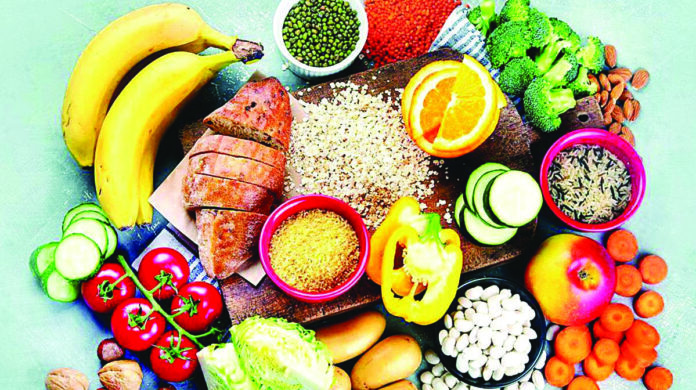Nutrients are substances essential for the life and growth of plants and animals. Plants get Nitrogen (N), Phosphorus (P), and Potassium (Kalium), and micronutrients (minerals) from soil. They synthesise the three macronutrients, carbohydrate, protein, and fat (lipids), and many micronutrients (vitamins, mineral compounds, trace elements) required by humans and animals. We obtain vitamins B2, B12, and K from good microbes (microbiome) in our gut. Some nutrients are needed daily because the body does not store them. Many micronutrients are heat-labile and therefore obtained from raw foods. Antinutrients (phytates, tannins, lectins, and oxalates) are compounds synthesised by some plants to protect themselves and can reduce our ability to absorb essential nutrients. These can be reduced by sprouting, fermentation, or cooking.
CARBOHYDRATES: These are our primary source of energy. Sugars, starches, and fibre are the three types of carbohydrates in food. Glucose, fructose, and galactose are monosaccharide sugars, and sucrose (table sugar), lactose (in milk), and maltose are disaccharides made of two monosaccharide sugars and are easy-to-digest simple carbohydrates. Starches (digestible) and fibre (not digestible) are complex carbohydrates made up of long chains of monosaccharides. They are found in grains like wheat, rice, oats, corn, millets, in starchy vegetables like potatoes, peas, and corn, and legumes like beans and lentils. Monosaccharides are readily absorbed and hence cause a sudden spike in blood glucose levels, triggering a surge of insulin release, followed by a sudden drop in blood glucose levels, triggering hunger. Complex carbohydrates need to be broken down by digestive enzymes and gut microbes over many hours. Hence, glucose levels are steady, and satiety is prolonged over 6 hours. Starch is classified as rapidly digestible starch (RDS), slowly digestible starch (SDS), and resistant starch (RS) that is not digested and is fermented by microbes in the large intestine. Cooking improves the digestibility of certain starches.
PROTEINS: Are essential for building and repairing tissues, and also contribute to energy production. Proteins consist of amino acids and may be globular, fibrous, or membrane-bound. They are broken down to amino acids in the gut, absorbed, and used to build body proteins in muscles and tissues, enzymes, and hormones. Animal proteins, found in meat, poultry, fish, eggs, and dairy, are considered complete proteins, meaning they contain all nine essential amino acids. Plant proteins, found in legumes (beans, lentils, and peas), nuts, seeds, and vegetables, may lack one or more essential amino acids, though some, like soybeans, quinoa seed, and amaranth seed, are complete. A combination of plant proteins can have all essential amino acids. The western protein obsession originated from pemmican, a calorie, protein, and fat-rich native food that was vital for survival in harsh northern Canadian conditions, where fresh food was not available. The Pemmican War between the two companies, HBC and NWC, from 1812 to 1821, was sparked by the Pemmican Proclamation issued by the British governor Miles MacDonnell, which disallowed any person from exporting pemmican. Pemmican is a mixture of tallow, dried meat, and dried berries with only one percent carbs, 79 percent fat, and 20 percent protein. The human body can store fat or carbohydrates, but cannot store protein. Excess protein is either excreted (stressing the liver and kidneys) or converted into fat and stored, or used for energy.
FATS: Fats provide energy, help absorb vitamins, and are important for hormone production. There are three types of food fats: unsaturated (monounsaturated and polyunsaturated) are liquid at room temperature, saturated are solid at room temperature, and trans fats. Unsaturated fats, particularly omega-3 and omega-6, are beneficial for health. Monounsaturated fats are found in avocados, olive oil, nuts (almonds, pecans), and canola oil. Polyunsaturated fats are found in vegetable oils (corn, soybean), fatty fish (salmon, tuna, mackerel), walnuts, and flax seeds. Saturated fats are present in fatty meats, dairy (butter, cheese, cream), and a few plant-based sources like coconut and palm oil. They raise LDL (“bad”) cholesterol levels, increasing the risk of heart disease. Trans fats are created when vegetable oils are hydrogenated, and are present in margarines, snack foods, baked, and fried foods. These raise LDL cholesterol and lower HDL (“good”) cholesterol, increasing the risk of heart disease. Reheating and reusing cooking oils multiple times, especially at high temperatures, can lead to the formation of trans fats. The ketogenic diet (high in fat, low in carbohydrates) may have been inspired by pemmican. It was developed in the 1920s as a medical treatment for epilepsy, specifically to mimic the effects of fasting and reduce seizures. It has been used as therapy for other conditions, including cancer, diabetes, and Alzheimer’s disease. Consume unsaturated fats (monounsaturated and polyunsaturated) in moderation and limit or avoid saturated and trans fats for better health. Excess body fat leads to multiple health issues detailed in an earlier article.
MICRONUTRIENTS: Deficiencies in micronutrient intake result in significant immune system and other health issues. Vitamins regulate various bodily functions. Essential vitamins are vitamin A, vitamin B1 (thiamine), vitamin B2 (riboflavin), vitamin B3 (niacin), vitamin B5 (pantothenic acid), vitamin B6 (pyridoxine), vitamin B7 (biotin), vitamin B12 (cobalamin), vitamin C, vitamin D, vitamin E, vitamin K. Minerals play vital roles in regulating bodily processes and functions such as nerve and muscle function, release of energy, and in bone and teeth health. The human body requires essential macrominerals in larger quantities and trace minerals in smaller amounts. Macrominerals: Calcium is needed for building and maintaining strong bones and teeth, muscle contraction, blood clotting, nerve transmission, and cell signalling. Phosphorus with calcium builds strong bones and teeth, and it helps in the release of energy. Magnesium supports many body functions, including energy release, nerve and muscle function, blood sugar control, and blood pressure regulation. Sodium helps regulate blood pressure and blood volume, and is important for muscle and nerve function. Potassium is crucial for heart, cell, skeletal, and muscular functioning, and helps maintain normal blood pressure. Chloride as an electrolyte helps maintain fluid balance in the body and is important for digestion. Sulfur is a component of amino acids and other important molecules in the body. Trace minerals required are iron, zinc, copper, selenium, iodine, cobalt, chromium, manganese, molybdenum, and fluoride. Flavonoids, bioflavonoids, and choline are other desirable micronutrients.
GOOD GUT MICROBES: Dietary fiber is a key nutrient for promoting a healthy gut microbiome. The gut microbiome plays a crucial role in producing and processing nutrients for the host. It synthesizes significant amounts of vitamin K and various B vitamins, including biotin, cobalamin, folates, nicotinic acid, pantothenic acid, pyridoxine, riboflavin, and thiamine, and aids in the absorption and utilization of minerals iron and calcium. Additionally, gut bacteria ferment dietary fibers and other complex carbohydrates, producing short-chain fatty acids (SCFAs) like butyrate, acetate, and propionate, which are vital nutrients for the host. Butyrate is a major energy source for colon cells, while acetate and propionate can be absorbed and used by the body for various metabolic processes.
ANTINUTRIENTS: Antinutrients are compounds found in plant-based foods that can reduce the body’s ability to absorb essential nutrients. Common antinutrients include phytates, tannins, lectins, and oxalates. Phytates (Phytic Acid) found in whole grains, nuts, seeds, and legumes can bind to minerals like iron, zinc, and calcium, making them less available for absorption. Tannins present in tea, coffee, cocoa, some legumes, and fruits interfere with mineral absorption. Lectins found in whole grains, legumes, and some nuts and seeds can bind to the lining of the digestive tract, interfere with nutrient absorption, and cause digestive discomfort in sensitive individuals. Oxalates found in green leafy vegetables, potatoes, beans, and beets bind to calcium, reducing its absorption. They also form urinary stones. Protease Inhibitors found in legumes and grains interfere with the digestion of proteins. Antinutrients can be reduced by heating, or by soaking and sprouting grains, legumes, and seeds to reduce phytate levels, or by fermentation, where applicable, to lower phytates and tannin content. Eating a variety of plant foods or avoiding mixing foods containing antinutrients with nutrient-rich foods can be beneficial.
NUTRIENTS LOST ON HEATING: Heating food leads to nutrient loss, particularly of heat-labile, water-soluble vitamins like C and B vitamins, and minerals that can leach into the cooking water. Fat-soluble vitamins like A, D, E, and K can also be affected, especially with prolonged heating or high temperatures like boiling and frying. Cutting vegetables into smaller pieces can increase nutrient loss, as more surface area is exposed to heat and water.
A balanced diet containing all nutrients, no antinutrients, and maintaining a good gut microbiome is essential for health.
Dr. P.S.Venkatesh Rao is a Consultant Endocrine, Breast & Laparoscopic Surgeon, Bengaluru.








